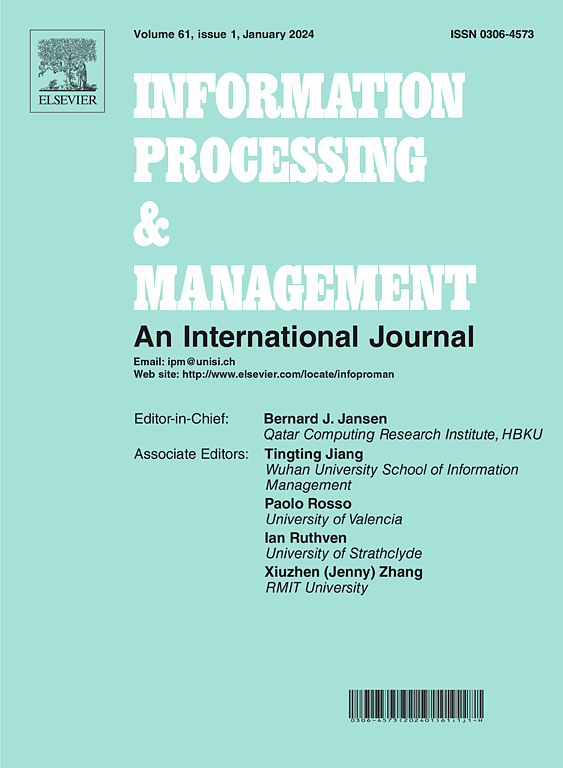图上的信息瓶颈驱动提示,用于统一下游的少量分类任务
IF 7.4
1区 管理学
Q1 COMPUTER SCIENCE, INFORMATION SYSTEMS
引用次数: 0
摘要
受提示在自然语言处理中的成功启发,提出了基于图提示的分类方法来解决有限实例条件下的分类任务。最近的基于图提示的方法通常采用链接预测作为预训练任务,这使得预训练任务与下游分类任务之间存在差距,从而将不相关和有噪声的特征引入下游任务。为了解决这个问题,我们提出了一个名为扩散图提示(Di-Graph)的框架,该框架由三个主要部分组成,即扩散预训练,图提示层和信息瓶颈优化器。具体来说,扩散预训练旨在通过扩散过程获得稳定的节点特征,减小预训练任务与下游任务之间的差距。图提示层通过捕获图中的结构和节点特征来增强预训练模型,以利用其知识。信息瓶颈优化器通过保留输入数据的最小充分统计量来帮助模型丢弃冗余特征。在五个公共图数据集上的大量实验结果表明,我们的Di-Graph模型在节点和图分类任务的准确性方面都超过了最先进的模型。特别是,对于图级任务,在BZR数据集上,Di-Graph比之前的最佳模型(GraphCL)实现了6.50%的平均性能增益。对于节点级任务,Di-Graph在蛋白质数据集上比最佳基线(GraphCL)提高了2.05%。本文章由计算机程序翻译,如有差异,请以英文原文为准。
Information bottleneck-driven prompt on graphs for unifying downstream few-shot classification tasks
Inspired by the success of prompt in natural language processing, the graph prompt-based methods are proposed to solve the classification tasks under the conditions with limited instances. Recent graph prompt-based methods typically employ link prediction as the pre-training task, which brings a gap between the pre-training task and the downstream classification task, thus introducing irrelevant and noisy features to the downstream tasks. To tackle this issue, we propose a framework called Diffused Graph Prompt (Di-Graph), which consists of three major components, i.e., the diffused pre-training, a graph prompt layer, and an information bottleneck optimizer. Specifically, the diffused pre-training aims to obtain the stable node features with a diffusion process, mitigating the gap between the pre-training tasks and the downstream tasks. The graph prompt layer enhances the pre-trained model to leverage its knowledge via capturing both the structural and node features in graphs. The information bottleneck optimizer helps the model discard redundant features by retaining the minimal sufficient statistic of the input data. Extensive experimental results on five public graph datasets demonstrate that our Di-Graph model surpasses the state-of-the-art model in terms of accuracy for both node and graph classification tasks. In particular, for graph-level tasks, Di-Graph achieves an average performance gain of 6.50% over the previous best model (GraphCL) on BZR dataset. For node-level tasks, Di-Graph achieves a 2.05% improvement over the best baseline (GraphCL) on PROTEINS dataset.
求助全文
通过发布文献求助,成功后即可免费获取论文全文。
去求助
来源期刊

Information Processing & Management
工程技术-计算机:信息系统
CiteScore
17.00
自引率
11.60%
发文量
276
审稿时长
39 days
期刊介绍:
Information Processing and Management is dedicated to publishing cutting-edge original research at the convergence of computing and information science. Our scope encompasses theory, methods, and applications across various domains, including advertising, business, health, information science, information technology marketing, and social computing.
We aim to cater to the interests of both primary researchers and practitioners by offering an effective platform for the timely dissemination of advanced and topical issues in this interdisciplinary field. The journal places particular emphasis on original research articles, research survey articles, research method articles, and articles addressing critical applications of research. Join us in advancing knowledge and innovation at the intersection of computing and information science.
 求助内容:
求助内容: 应助结果提醒方式:
应助结果提醒方式:


